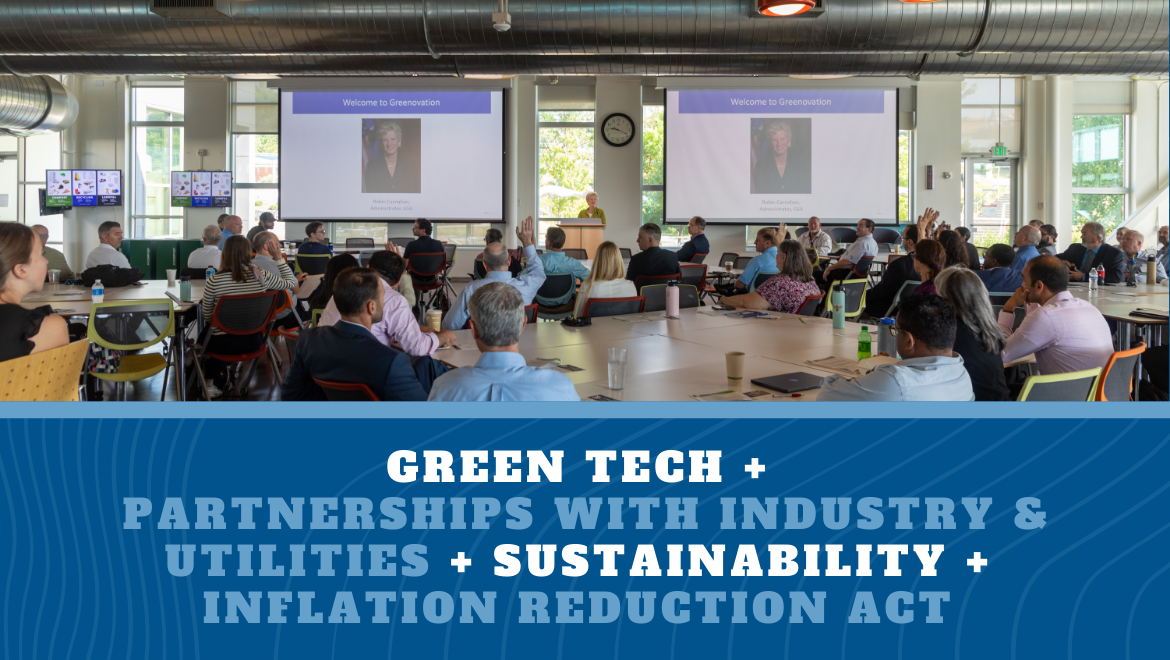
Boosting sustainability through partnerships
As GSA works to optimize the federal portfolio while making it more sustainable and resilient, we know that partnership is crucial. That was a key topic at the inaugural Greenovation Summit in Golden, Colorado, on July 17-18.
This event rallied energy service companies, innovative technology vendors and government to discuss the next steps toward achieving a clean-energy future, including 100% net-zero federal buildings by 2045. Between national and agencywide sustainability goals, and funding from the Inflation Reduction Act, GSA has a big role to play.

“The Federal government is the biggest buyer of goods and services in the world. We can use that buying power to really change how markets operate, spur demand for low-embodied carbon building materials, carbon-free electricity and energy efficient and clean technologies. And that’s exactly what we’re doing,” said GSA Administrator Robin Carnahan.
The Greenovation Summit gave participants an opportunity to collaborate with each other to meet these goals, with an emphasis on three focus areas: bringing in emerging and sustainable technology; using Energy Savings Performance Contracts; and, focusing on specific, high-demand technology areas. The objective of the event was to demonstrate to the ESCOs that the government wants new innovative technologies to be deployed in its buildings and that there are innovative vendors that have been already derisked and demonstrated.
Innovative, sustainable tech
One way GSA brings in innovative, sustainable technology is through the Green Proving Ground program. GSA oversees over 370 million square feet of federally owned, leased or managed properties – equivalent to more than 6,300 football fields – and we capitalize on that extensive real estate portfolio by introducing and evaluating innovative building technologies in real-world settings.
The Green Proving Ground program provides an opportunity to partner with the private sector to test green technologies on a massive scale. Since 2011, GPG has evaluated more than 100 emerging technologies, with 23 of those technologies implemented across 700 facilities, saving $28 million in annual costs. Now, GSA is poised to more than triple the number of technologies in the GPG program.

Energy Savings Performance Contracting (ESPC) is another approach GSA uses to make cost-effective, energy-saving building improvements without upfront expenses. The process involves a facility owner selecting an Energy Service Company (ESCO) and contracting with them to complete the project. The ESCO is paid with the savings realized from efficiency upgrades.
Last year, GSA announced that we would use almost $1 billion from the Inflation Reduction Act to deploy emerging and sustainable technologies across the federal footprint. That funding will unlock even more dollars because we’re leveraging public-private partnerships to do this work. Specifically, by entering into ESPCs with private companies, we’ll bump up the total investments in these projects to nearly $1.9 billion.
By incorporating more emerging technologies, like those that have been evaluated through our GPG program, into performance contracts, GSA hopes to drive down operational costs and rapidly accelerate its progress toward a net zero federal footprint.
“As we deploy these historic investments, we’re going to need more next-generation technologies, more on-site generation and storage, and more innovative ideas to not only electrify buildings, but make them net zero,” said Carnahan. “That’s why our Green Proving Ground program is so important – it leverages GSA’s extensive real estate portfolio to evaluate innovative building technologies in real-world settings. And - importantly - this new tech can drive down operational costs.”
Diverse needs, common trends
GSA’s real estate portfolio has many diverse needs based on each specific building and the community it inhabits. However, there are common trends in emerging technologies where GSA has specific needs:
- Deep Energy Retrofits improve the energy efficiency and reduce the carbon footprint of an existing building through a combination of specific energy conservation measures including ongoing monitoring and controls.
- All-Electric Buildings and All-Electric Vehicle Fleets eliminate the use of fossil fuels in buildings and vehicle fleet operations.
- Healthy and Resilient Buildings enhance occupant comfort and building health, while minimizing climate-related and other vulnerabilities.
- Low Embodied Carbon Building Materials reduce lifecycle emissions associated with materials used for facility construction, renovation, and reuse.
- Net-Zero Operations reduce or eliminate the need for fossil-fuel equipment through a combination of on-site renewables and off-site carbon-free electricity.
- Packages of Emerging and Sustainable Technology Solutions combine to create deeper energy or emissions reductions for a facility or campus.
Technologies like these will be tested at GSA’s Applied Innovation Learning Labs to identify replicable combinations that deliver net-zero operational emissions. The evaluations are intended to validate the technical and operational characteristics of the technologies and their potential for future wide-scale adoption.
“Bringing tech into our buildings is a win-win – we test them and help prove that they really deliver, and where they do, we focus on wide-scale deployment across our building portfolio,” said Carnahan. “That helps build the market for these emerging technologies while helping us meet our climate, energy and management goals.”
Greenovation panelists offered insights on emerging tech and performance contracting, and participants interacted with vendors and experts during networking and breakout sessions. Summit presenters and attendees shared the vision of working together to harness emerging technologies to reduce energy use and greenhouse gas emissions, create jobs and taxpayer savings, and support healthier communities.
Going forward, Carnahan has big hopes for these efforts, saying “our goal is that Greenovation will not just become an annual event, but a place where we can work together.”

 U.S. General Services Administration
U.S. General Services Administration
